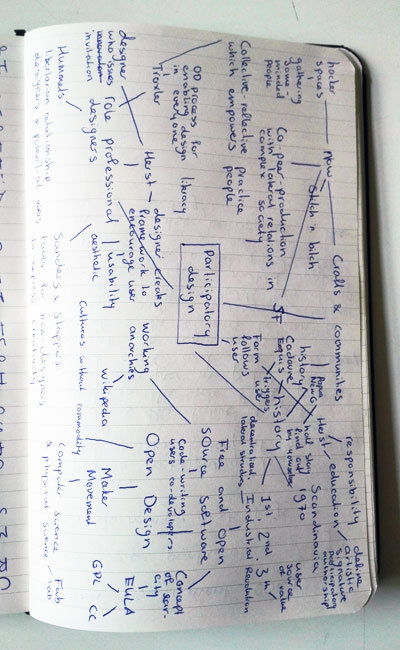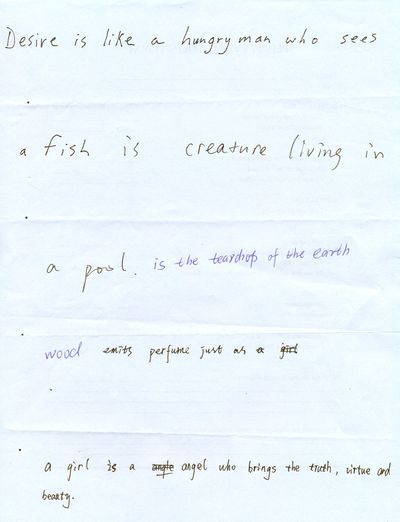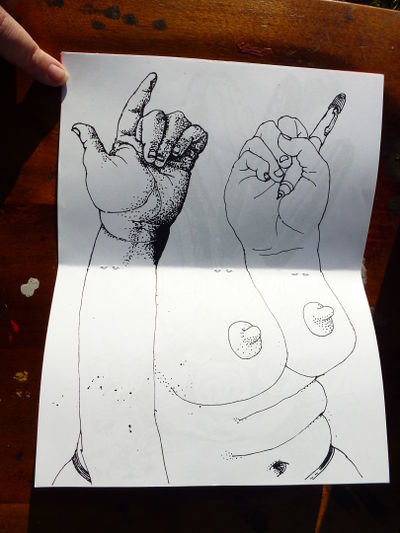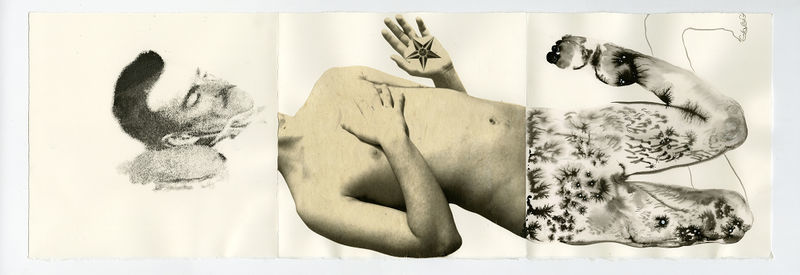Difference between revisions of "Joeke Written Assignment"
| Line 73: | Line 73: | ||
[[File:Brain01.jpg|400px]] [[File:Brain02.jpg|400px]] | [[File:Brain01.jpg|400px]] [[File:Brain02.jpg|400px]] | ||
| − | == | + | == BOOK: Re-inventing the Art-school 21st century == |
Essay #4 The Need for Open Design<br> | Essay #4 The Need for Open Design<br> | ||
Revision as of 14:51, 14 October 2015
Contents
ORIENTATION
Questions and Anwers:
1. What is your craft? (define your discipline, method or approach)
An important part of my craft is documenting my work process and making it accessible for others.
By doing this, a project is never finished, because others will participate and maybe use your ideas and techniques for their own projects.
During my internship at Instructables and my job at Stadslab I learned a lot about Open Design and sharing communities.
I use Instructables during my projects and also upload projects on the website, to get feedback and collect new ideas. I use objects from Thingiverse, transform the objects and place them in another context so they fit my project.
2. What are the tools and media of your craft?
Sharing communities: Instructables, Thingiverse, Lynda, Wikipedia.
Open workstations: Fablabs, Open Wetlab, workstations academy.
Open source tools: Arduino, Processing, Ultimaker (basic). But also experimenting with materials and photographing the process
3. What are the borders of this practice? (what new media technologies have arisen / what is its future of the field))
The ideas of Open Source and peer production spilled over from the digital domain of software into material domains of hardware and manufacturing.
Now these ideas are also getting involved in more practices. Such as education. In his essay 'The Need for Open Design' (from the book 'Re-inventing the Art School 21st Century'),
Peter Troxler sais that the voice of the student still is notably absent, and teaching at times lacks concern for students' aspirations.
Mushon Zer-Aviv calls in the article 'Learning by Doing' from the book 'Open Design Now' tutorials an involved interactive design task for art students.
Bio-hacking is also an interesting development. By making tools and knowledge available, Open Wetlab encourages artists and designers to take part in the biosciences.
Even society is subjected to open source experiments at the Institute for the Future, an influential think tank in Palo Alto:
‘The Governance Futures Lab brings social inventors and futures thinking to the challenge of designing better systems of governance.’
The article about Open Source Government on the IFTF blog quotes: ‘Well, if we humans can use open-source technology tools to collaboratively write the best encyclopedia in the world,
and build the core of the world’s most popular mobile operating system, what is to stop us from collaboratively rewriting democracy, as we know it?’
http://www.iftf.org/govfutures/
4. Connect to a historical discourse and give concrete examples (images too please) of inspiring historical and contemporary practitioners.
The EULA’s (end-user license agreement) treated software as a form of artistic expression and made it impossible for others to share, copy, re-sell or ‘fork’ (edit) the software.
In this case the ‘concept of scarcity’ was applied. This is similar to original paintings; they draw their value from social scarcity, multiplication would destroy the value of it.
But, digital copies can’t be compared to paintings. Digital copies are absolutely identical and copying won’t alter the original code. So the ‘concept of scarcity’ doesn’t work.
Creative Commons reverse content scarcity created artificially by copyright.
The Open Source Software development, described by Eric S. Raymond: ‘release early and often, delegate everything you can and be open to the point of promiscuity’.
This is leading to a movement of users who become co-developers, because a lot of them can write code as well.
These ideas of Open Source Software led to a maker movement, focused on bringing together computer science and physical science.
The concept of Fablab started at the Media Lab of MIT by Neil Gershenfeld and spread out all over the world. He says in his TED talk that Fablabs now have to focus on how to improve social and organizational engineering.
Eric J Wilhelm was a student at MIT and founded Squid Labs, an engineering and technology company. Instructables started as an internal Squid Labs project.
In 2011, Autodesk announced the acquisition of Instructables. All the staff of Instructables contributes to the site by sharing projects.
Contemporary practitioners are: Eric J Wilhelm (CEO Instructables), Randy Sarafan (Manager Design Studio Instructables), The Oakland Toy Lab (Artist in Residence Instructables),
David Sjunnesson (founder Box Creator), Ingrid Nijhoff (project Levende Pixels at Open Wetlab), Mickael Boulay (users as partners at WAAG Society), Droog Studio (Design for Download).
http://opendesigncontest.org
My Fantastic Forgeries project & Open Design:
According to Peter Troxler is Open Design a process for enabling design literacy in everyone.
The role of the professional designer will be to guide users and to deal with complexity for making tools needed by non-designers to express themselves creatively.
During the project of Fantastic Forgeries I focus on making tools that anyone can use for making a replica of the artefact ‘Birth of Bubbles II’.
This raises the critical question: can everyone be an artist? And is the artefact still valuable if it's replicated many times?
Do we have to question the concept of scarcity of artefacts?
Quotes:
'Openness is more than a commercial and cultural issue, it's a matter of survival.' - John Thackara
'A tutorial is an involved interactive design task.' - Mushon Zer-Aviv
'Finally, the ordinary person is in the unique position of being able to make almost anything, with off-the-shelf modules, parts community and shared code.' - Bre Pettis
Feedback Jon: think about how you write the essay and how to structure your text. Experiment with participatory writing, use others' texts.
What does craft mean for communities? What is the difference between the hobbyist and designer?
Writing an essay can also help you to explorer your position in crafts.
Book: 'Participation s Risky' by Liesbeth Huybrechts
Brainstorming:
BOOK: Re-inventing the Art-school 21st century
Essay #4 The Need for Open Design
Peter Troxler
Open Design is a participative method, a collective-reflective practice and a dynamic, social and iterative design process which invites users to modify a design.
1. Industrial Heritage
The development of information processing and communication technologies for controlling energy and flows of materials within the industry.
This created new qualities of experience and contingent possibilities how to engage social, political and economic demands with technology.
2. Third Industrial Revolution: Societal Changes 21st Century
First industrial revolution focused on a control paradigm, the second on managerial capitalism and the third on individuals, self-expression and participation.
Zuboff and Maxmin call this ‘distributed capitalism’, a paradigm that serves the needs of individuals and treats them as a source of value. It is the costumes who determines what a business is and what valuable is.
According to Rifkin the third revolution promotes lateral power, because internet and energy sources allow decentralized, lateral structures.
Examples of working anarchies are Wiki, Open Source Software. But businesses such as Apple, Google and Walmart are definitely not and don’t benefit society at large.
3. Open Source Freedoms
FOSS means Free and Open Source Software and have a legal proposition to obliterate (erase) intellectual property protection and a social proposition for peer-to-peer production.
This means that any piece of code may be used for any purpose, even commercial purposes.
This is diametrically opposite of EULA, this agreement treats software as a form of artistic expression and applies the concept of scarcity.
This concept draws value from social scarcity, multiplication will destroy this value. But this concept doesn´t work for digital copies, because they are identical and don´t alter the original.
Creative Commons licenses reverse the content scarcity created artificially by copyright.
4. Open Source Practice
Raymond describes the FOSS development: ‘release early and often, delegate everything you can and be open to the point of promiscuity’.
Users become co-developers, because they can write code as well.
5. Open Hardware and Maker Movement
The ideas of FOSS and peer production spilled over from the digital domain of software into the material domain of hardware and manufacturing. This is called the Maker Movement.
Neil Gershenfeld of the MIT was looking for new ways of bringing together computer science and physical science and created the Fablab.
Other Fablabs arised around the globe and became part of the Fablab charter. Gershenfeld sais they now have to focus on how to improve social and organizational engineering.
At the Institute from the Future at Palo Alto they even experiment with prototypes of citizen-led governance.
6. Open Design in Art Education and Practice
Academic art education experienced an utilitarian reorientation during industrial revolution.
Economic and cultural imperialism and globalization led to almost worldwide dissemination (scattering seeds) of the utilitarian art education.
Felix Stalder sais that the 'commodity culture' creativity treats as a scarce resource. Cultures without commodity moves authorship from individuals towards
groups, networks and communities. Boundaries between artists and audiences become blurred. Creative processes are organized as networks.
7. Open Design Between Sharing and Protecting
Pragmatic approach of Open Design: distribute the blue prints with CC licenses and get a fair share if someone makes big money with it.
Not all the design disciplines have a strong tradition of intellectual property, for example fashion, hairstyles etc.
In these disciplines there's no need for opening design in legal terms.
8. Open Design as Collaborative Practice
In 1970 there was already a collective research approach, called participatory design, in Scandinavia.
Co-design means that the collective creativity is applied across the whole span of the design process.
According to Sanders and Stappers, the new role of the professional designers will be to guide users and to make generative tools
needed by non-designers to express themselves creatively.
Open Design is a process for enabling fesign literacy in everyone.
BOOK: Open Design Now
Case: Form Follows User
Deanna Herst
Participatory design changed the role of the designer from an author of finished products into a developer of frameworks of open works.
This encorages the user to complete a form or product and they share the responsibilty for the design, in a process directed by the designer.
Important are the usability and the aesthetics, the last one is complementing the functional properties.
The next step is to explorer participatory strategies derived from other disciplines, such as storytelling.
For example cadavre equis, a structure that triggers its users.
WRITING METHOD: PARTICIPATORY WRITING
Participatory writing.
Inspired by participatory poetry and drawings called Cadavre Exquis/Exquisite Corpse.
This method is to assemble a collection of words or images. Collaborators add to a composition by following a rule or being allowed to see only the end of what the previous collaborator wrote or drew.
Invented by Surrealists and similar to a game called Consequences, found before 1918.
Similar to a Papua New Guinean tradition to tell half a story and let the listener finish the story themselves.
Dianna Herst about Form Follows User (book: Open Design Now): 'Structure that triggers its users, but where the designer issues the invitation.'
Examples:
Poetry made at an Exquisite Corpse workshop ('A Community Poem'). Drawing made by Noah Ryan and Erica Parrott.
Drawing made by Bea Nettles, Steve Kostell and Megan Diddie
Experiment
After research to participatory design, experiment to involve different 'users' (or readers) in the writing process.
Writing down a couple of important elements of participatory design and let the 'users/readers' finish the sentences.
By doing this I want to examine how effective and surprising this way of writing is and if it fits my way of writing.
Maybe in the end even write the whole essay in a participatory, interactive way.




